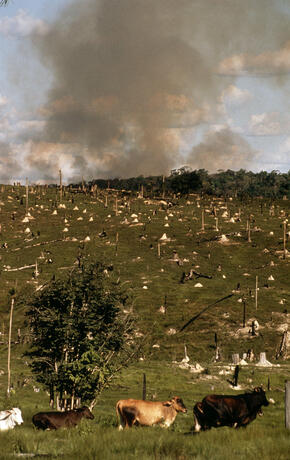What Is Mercury Made Of What Is Earth's Planet Makeup
Despite its mighty splendor, the Amazon's forest and freshwater systems are fragile and at risk.
Land Speculation and Agricultural Expansion
In that location are several economic incentives in place that contribute to deforestation in the Amazon: Real manor speculation is a major commuter. The toll of country in the Amazon tin increase up to tenfold in one case the woods has been cleared.
Amazon forests also suffer as global demand for products such every bit beef and soy increases. Forests are cleared for more and more cattle grazing pasture and cropland. These growing industries displace small-scale farmers, forcing them into forested areas they must clear to sustain themselves.
Cattle pastures occupy 80% of deforested areas in the Amazon. Pasture runoff contaminates rivers. Burn down used to manage fields often spreads into the remaining forests. The deforestation caused by ranching too contributes to climatic change, releasing 340 million tons of carbon into the atmosphere every year.
Learn more than about the food behind deforestation.

Poorly Planned Infrastructure
Transportation and energy infrastructure are essential for national and regional evolution, but when they are poorly planned, negative impacts tin can exceed short-term benefits. For case, building new roads exposes previously inaccessible areas of forest to illegal and unsustainable logging as well equally illegal or unplanned settlements and agricultural expansion.
Hydropower is now used to meet Brazil'south growing demand for energy, but many dams are beingness constructed in areas of high conservation value. The dams:
- disrupt river connectivity
- cake the range of many aquatic species, including migratory fish and river dolphins
- interfere with some subsistence and commercial fisheries
To minimize the impacts of hydropower, WWF is promoting scenario planning (including a "no dams" scenario in some rivers) that explores culling energy options, sites hydro dams with the entire organization in listen, and promotes transboundary cooperation for river basin management. WWF has also mapped out freshwater connectivity corridors across the basin. This work has allowed us to pinpoint stretches of river that are most disquisitional for connectivity to be maintained for the future health of the Amazon basin, its communities, and flagship freshwater species.
Illegal and Unsustainable Natural Resource Extraction
There is high need for the natural resources found in the Amazon but weak law enforcement to safeguard them. In addition, inefficient extraction processes lead to the devastation of nature and wildlife. For example, mining activities contribute to soil erosion and water contamination. Mercury contamination of Amazonian waters from artisanal mining is of particular business concern given the consequential impacts on human health and contamination of the food chain for fish and wildlife.
WWF works to promote best practices and subtract environmental damage from:
- gold mining
- oil exploration
- illegal logging
- overharvesting of fish and other aquatic species
Climate change
The Amazon is critical to our efforts to avert a climate catastrophe. Water vapor released from the Amazon creates vast "flying rivers" in the atmosphere, which influence rainfall and thus agricultural output in key and southern Southward America. And the billions of tons of carbon stored in the Amazon rain forest is of global importance to slowing climatic change.
Just the Amazon is threatened by ascension deforestation. Unprecedented droughts are happening with growing frequency. Dry out seasons are hotter and longer. Long dry spells wither crops, decimate fisheries, and lead to forest fires. This can result in significant shifts in the makeup of ecosystems and a loss of species.
According to many notable scientists, including longtime friend of WWF Tom Lovejoy, the Amazon is close to a tipping signal past which it will no longer be able to sustainably support itself. To ensure the Amazon's future, for its people and biodiversity, deforestation in the region should not exceed 20%, and it is already at 18%. Our vision is one of null cyberspace deforestation in the Amazon to safeguard this globally important ecosystem.
Source: https://www.worldwildlife.org/places/amazon
Posted by: perezthemad.blogspot.com

0 Response to "What Is Mercury Made Of What Is Earth's Planet Makeup"
Post a Comment